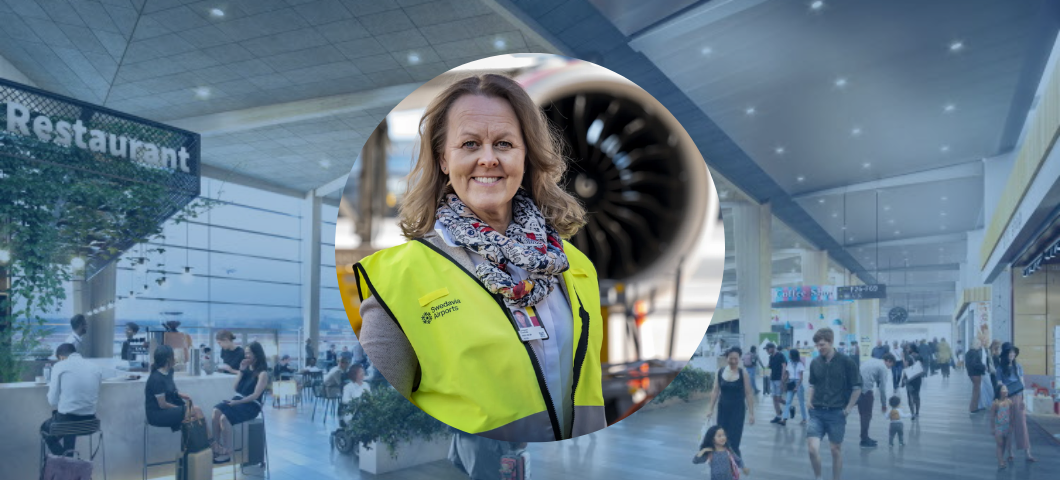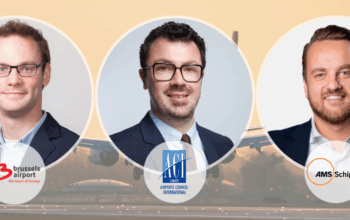
Swedavia’s new commercial strategy
We have the pleasure of hosting Charlotte Ljunggren, the Marketing and Commercial Development Director at Swedavia, as our Five Minute Feature’s guest this month. We delved into Swedavia’s latest commercial strategy, with a particular focus on the exciting Marketplace project at Stockholm Arlanda Airport.
Can you tell us more about the inspiration behind the development of the new Marketplace that will soon open at Stockholm Arlanda Airport?
We are very excited about the new major milestones in our passenger experience journey at Stockholm Arlanda Airport. Over the past decade, we have intensified our investments at Arlanda, Sweden’s biggest airport, in order to further develop a modern, inspiring airport to meet our passengers’ needs and for the multimodal travel of tomorrow. This summer we will open our new state-of-the-art security checkpoint. The next key step will be the opening of the first phase of our brand-new 11,500 square meters central Marketplace after the summer, with subsequent phases gradually taking place in 2024 and early 2025. The Marketplace – with more than 40 new shops and restaurants – is the result of a review of our retail commercial strategy and will bring the biggest change ever in our commercial offering at the airport.
We are creating a completely new destination for retail, food and beverage with a clear Scandinavian commercial design theme. The airport’s local connection to Stockholm, Sweden and Scandinavia will be expressed in the Marketplace’s commercial design, local concepts and Swedish products. Value for money and a wide range of prices rather than ‘luxury shopping’ have been keywords in our thinking, based on our research findings. Our passengers should find something to suit all budgets and occasions. This will not only significantly expand and diversify the commercial offering at Arlanda but, we believe, will also make the Marketplace a travel destination in its own right.
Similarly, our commercial review will have a positive impact on our other airports, with changes obviously depending on their size. Göteborg Landvetter Airport, the second biggest in Sweden, involves some 20 food and beverage outlets and retail stores.
What were the key factors that led to the development of a brand-new commercial strategy for Swedavia, with the new Marketplace being a real-life enactment of this?
Our overall aim for Arlanda is to become the Nordic region’s leading transport hub but also to ensure that all ten of our airports across Sweden remain relevant in terms of future travel needs. Air travel is making a strong post-pandemic recovery in Sweden and will no doubt remain a key transport mode in a country with a geographic location like Sweden’s.
Based on extensive customer and market analysis as well as trend research, we decided on a new commercial strategy for our ten airports in 2020. One important aim was to develop the retail, food and beverage offerings whilst at the same time diversifying the range of our prices and offers. With this new commercial offering, we want to strengthen our relationship with passengers. This will enable further passenger growth and provide the potential to boost commercial earnings, which is crucial in order for our airports to stay competitive.
How do you plan to ensure a varied offering and a wide range of prices at the Marketplace to cater to different customer preferences and budgets?
As a state-owned company and in compliance with procurement legislation, Swedavia must subject all contracts for commercial concessions at the airport to public tender. For the commercial launch of the Marketplace as well as for commercial operations at our other airports, we are conducting more than 100 public tenders with a value of about SEK 10 billion (EUR 1 billion). The contracts run for some five years, after which time they will be subject to a new tender. This strategy will enable us to review our commercial offering on a regular basis, ensuring that our offering stays relevant and matches our passenger needs, but also improve competition.
We have set different requirements based on the concept, price level and breadth of the offering. For food and beverage, the assortment ranges from fine and casual dining to grab-and-go and QSR. As for retail, it has been important to consider certain entry-level products at a lower price point in order to attract and be relevant to more passengers. We have also included criteria such as financial stability, environmental and climate transition work, previous experience, and how well the requirements for the concept have been satisfied.
Overall, we want our commercial offering to be perceived by passengers as giving them value for their money, regardless of the range on offer, and prices should not differ substantially from those for similar products and services in central Stockholm.
Could you elaborate on the Scandinavian design used and the atmosphere that will be created in the Marketplace to enhance the traveller experience?
The Marketplace is being built in the airport’s biggest terminal, Terminal 5, with a design that clearly features Scandinavian themes. That means clean lines, light tones, light wood and stone, which together constitute the backdrop for the Marketplace. Shops and restaurants will then be able to add their own unique commercial design.
We have specified requirements so that, in some cases, a given shop or restaurant must have a clear Scandinavian commercial design. In others, the operators themselves have chosen to have elements of Scandinavian design in their premises in order to adapt their concept and anchor it locally. However, our aim is not for everything to be characterised by Scandinavian design. We also have concepts that provide a more international feel in terms of their design and offering, particularly when it comes to food and beverage concepts.
In what ways will the new Marketplace offer a modern shopping experience for passengers, and what unique features or services can they expect from this space?
For food and beverage as well as retail, we have and will procure concepts that can be renewed and replaced over time. We work to a certain degree with a focus on multi-brand stores, which over time and compared to single-brand stores can work more flexibly with their assortment and thus adjust to prevailing trends in their segment and in that sense over time be more relevant to our passengers.
Considerable concept development work has been carried out regarding the future of retail pop-ups and how to implement this to make pop-ups a unique destination in the new Marketplace. The future food hall, which is a first at Arlanda, will also have a few units that will change continuously over the course of the concession contract in order to offer the latest food trends at the airport. We have also focused, above all in food and beverage, on digital solutions that will contribute to the speed of service, which will make it easier for our passengers.
Moreover, the section of the new Marketplace that we call The Veranda – a 4,000 square meter expansion towards the runway side of the airport built with a wooden construction frame, 8-meter ceilings and floor-to-ceiling windows – will be filled with a completely new offering of quality food and beverages and be a go-to destination at the airport.
What are your expectations for the success of the Marketplace, as the largest-ever investment in retail, food, and beverage outlets at Arlanda, in terms of passenger engagement and revenue generation?
The commercial offering is, of course, a crucial part of the overall experience of an airport. We believe that the total upgrade and renewal of all the commercial units at the airport will contribute positively to future customer satisfaction. The tender value is SEK 10 billion and the investment is expected to have a positive impact on Swedavia’s revenue, which will help us maintain competitive airport charges as well as finance future development at our airports. Although we are a state-owned company, we are not funded by taxes but rely solely on the revenue from our various commercial activities.
Looking ahead, what other concepts or businesses can we expect to see in the Marketplace in the future, and what factors will guide the selection process for these additions?
We are still in the process and have room to procure more concessions in retail, above all in fashion, beauty, accessories and design. The focus will be on a mix of Swedish/Scandinavian and international brands, which together will help fulfil our commercial strategy in terms of a wider range of goods and a broader price picture and enhance the sense of a local touch.
Swedavia has made significant efforts to reach net zero Scope 1 and 2 emissions, a pioneering feat achieved in December 2020. How has this commitment to sustainability and decarbonisation been integrated into the development of the new Marketplace at Arlanda Airport? Could you provide examples of specific sustainable practices or initiatives implemented in the Marketplace such as energy-efficient design, waste reduction or sourcing sustainable products? And what broader sustainability practices is the airport implementing to minimise the environmental impact of its commercial offering?
Sustainability and climate transition work always have a high priority at Swedavia, for our airports and in collaborations with our partners. We have been fossil-free in our own airport operations at our ten airports since 2020. This includes our own airport vehicles and purchased electricity and heating, for which we buy fossil-free alternatives. We are now continuing this work by supporting the industry in its climate transition journey.
In prioritising our climate transition work, we include our airport operations as well as development projects and set requirements in our public tenders. For example, we have chosen glulam beams instead of a steel framework, which significantly reduced CO2 emissions in the construction of the new Marketplace. Natural materials like laminated timber, which has been used in Arlanda’s Veranda, part of the Marketplace, have a much lower environmental impact.
When selecting partners for the Marketplace, we set out ‘shall’ requirements – our suppliers shall actively work to reduce their climate impact over time. It is a matter of suppliers working systematically to reduce their annual fossil carbon dioxide emissions.
Facts in brief about Stockholm Arlanda’s new Marketplace
Number of outlets: Over 40 new shops and restaurants
Floorspace: About 11,500 square metres.
Opening: Gradually, starting in the second half of 2023 through the end of 2024/beginning of 2025.
Total value of tender contracts, Swedavia: SEK 10 billion in commercial contracts for Swedavia’s airports.
Marketplace, phase 1, shops to open in 2023:
- Arlanda Airport’s main tax-free store
- Electronics, souvenirs, books, pharmacies and convenience stores
- Currency exchange, VAT refund desk
- Liquorice store (local hero)
Marketplace, phase 1, restaurants to open in 2023:
- QSR hamburgers (local hero)
- Casual dining restaurant, open 24/7
- Fast casual dining restaurant, green and healthy
- Grab-and-go
Contact information if you are interested in participating in Swedavia’s retail tender process:
Commercial operators that are interested in knowing more, or in taking part in the tender process, should feel free to contact us by email at etableringretail@swedavia.se.
Biography Charlotte Ljunggren
Charlotte Ljunggren has been Chief Commercial Officer of Swedavia since January 2019 and is a member of Swedavia’s Group Management team. She previously held the position of Airport Director at Göteborg Landvetter Airport, Sweden’s second-largest airport, for nearly a decade. Charlotte has more than 25 years of experience in the transport and travel service industry and has held various senior positions at Swedish as well as international companies such as Sea Containers, Color Line, Silja Line and Stena Line Group.



